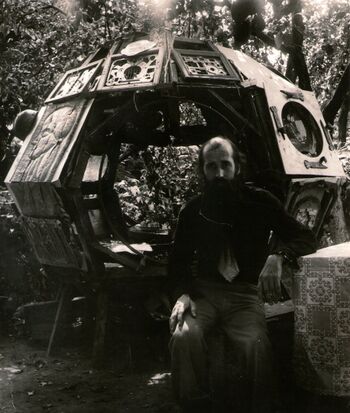Fedir Tetyanych
Fedir Kostiantynovych Tetyanych (Федір Констянтинович Тетянич) or Frypulia (Фрипулья, born Feodosiy Kostiantynovych Tetyanych, 17 February 1942, Knyazhychi village, Kyiv region - 18 February 2007, Kyiv) was a Ukrainian artist (monumentalist, painter, graphic artist, sculptor, performer), poet and philosopher, conceptualist. Member of the Union of Artists of the USSR and the Union of Artists of Ukraine (since 1973). He was one of the pioneers of performance and happening in the Soviet space, which he arranged under the exotic mask of a freak, a bright representative of the underground, and later a member of the new Ukrainian wave. As noted by the Encyclopedia of Modern Ukraine, "Kyivan F. Tetyanych created unusual installations ("freepools") and complemented them with performances in shocking clothes, performing on the streets, in galleries and respectable museums, destroying philistine tastes and stereotypes." (2022)
Fedir Tetyanych grew up during World War II in the village of Kniazhychi near Kyiv. There, through his early contact with land and nature, and against the backdrop of the armed conflict (as a child he was injured by a piece of a projectile), his idiosyncratic perception of rural cosmism and human responsibility for the surrounding world took form.
As an artist, Tetyanych worked against the constraints of various ideologies and disciplines. He was an author of monumentalist mosaics and decorative panels in the Soviet era, a chronicler of Ukrainian indigenous cosmologies and Cossacks’ anarchist history, a joyous performer, writer of cosmist and ecological manifestos, egalitarian hoarder of objects and an activist who wished to turn landfill sites and factories into theatres. All these labels apply yet collectively fail to encompass Tetyanych’s nonconformist legacy and prolific output.
In the 1960s, the artist began his first State commissions for monumental decorations in public space, which he often created using found items: discarded industrial waste, scraps of metal, cans, screws and shards of glass. These materials became prime matter for his future costumes and performances on the streets of Kyiv from the 1980s onwards.
Tetyanych considered his whole life to be one single performance, but he was more informed by science-fiction literature, cybernetics and cycles of nature than by any of his contemporaries in the field of avant-garde art. In the 1970s, he developed his own version of ecologically-informed cosmism, stemming from an awareness of infinite unity with the universe and mutual interconnectedness, which he called Frypulia. According to him, humanity, even if eventually turned into radio waves or rays of light, would carry information about itself and reappear at any point of space and time. Many of his works involve biotechnospheres, autonomous units for shelter, energy-storage and transportation. The artist made numerous drawings and watercolours imagining their future application, he also installed the actual models in public space; for example, by incorporating them into his State-commissioned monumentalist works. (2022)
Fedir Tetianych died in a Kyiv hospital on 18 February 2007, leaving behind his wife Hanna and two children, Bohdan and Lada. He was buried in Kyiv. (2022)
Publications[edit]
- Sergei Bublik (Сергій Бублик), Tereveni for Tricks [Теревені під витівки], ills. Fedir Tetyanych, Kyiv, 1993.
- Dmitry Desyaterik (Дмитро Десятерик), "Всесвіт Фріпулья" [The Universe of Fripulia], Den 40, 5 Mar 2004. Interview.
- Fedir Tetyanych. Fripuglia [Федір Тетянич. Фрипулья], Kyiv, 2009, 32 pp. A summary of the artist's life and work. It includes the main philosophical reflections, poems and drawings of Fedir Tetianych. [1]
- Fedir Tetyanych. Fripuglia [Федір Тетянич. Фрипулья], Kyiv: Антиквар, 2021.
- more
Literature[edit]
- Yuriy Zmorovych, "Фрипулья Forever (Федір Тетянич, 1942-2007)", Reflect 24, Chicago, 2007.
- Nikita Kadan, Yuri Leiderman, "Pryshchur muzeia" [Прищур музея], Prostory, 2016. Dialogue about Tetyanych.
- Daryna Gladun, "Нонконформізм у літературній спадщині Федора Тетянича", 2018.
- Елена Окунева, "Фрипулья: Федор Тетянич. Фрик или волшебник?", 14 Oct 2021.
- Maryna Chemerys, "Тетянич Фрипулья Федір (Феодосій) Констянтинович", Memoryon, c.2021.
- Марина Полякова, "Ефемерний Тетянич", 18 Feb 2022.
- more
Links[edit]
- Website
- Profile on Pinchuk Art Centre incl. archive of his work and writing
- Profile on Ukrainian Unofficial
- Profile in the Library of Ukrainian art
- Documentary film about Fripulya, dir. Svyatoslav Feofilaktov, 2011, 89 min.
- Video with Tetyanych from Oleksandr Dirdovskyi, c.2013
- Works in Grynyov Art Collection
- Exhibition, Pinchuk Art Centre, 2017. Photos. Review: Nosko (Prostory).
- Exhibition, Vienna, 2022
- Wikipedia-UK
